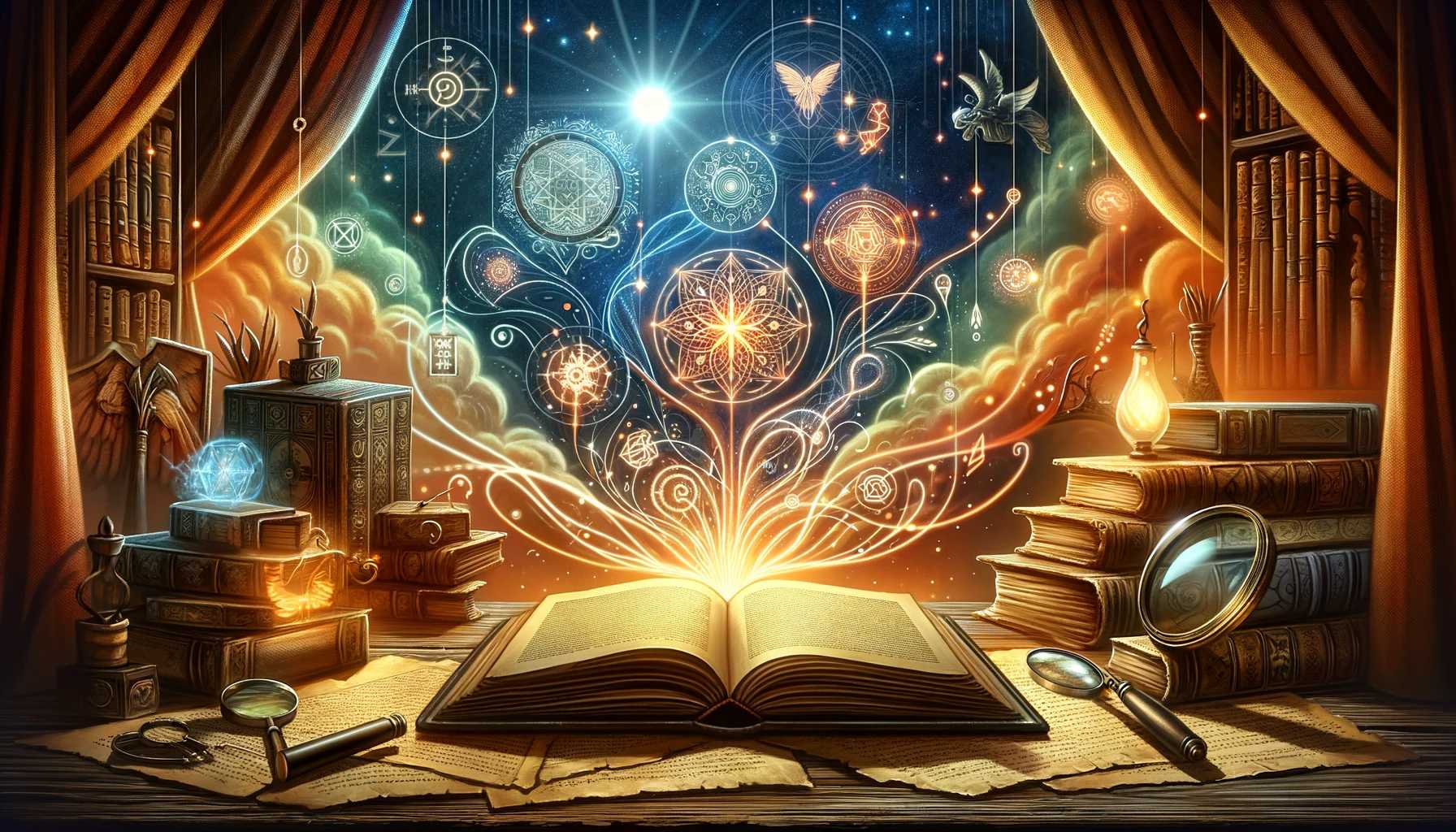Hidden Meanings: Unmasking Symbolism in a Book
Hey there, fellow book lovers and literary enthusiasts! Have you
ever found yourself captivated by a novel, feeling that there’s something
deeper lurking beneath the surface of the words? If so, you’ve likely
encountered the fascinating world of literary symbolism. Symbolism can add
layers of meaning to a story, providing richness and depth that engage readers
in a more profound way. Today, let’s dive into the realm of symbolism in
literature and explore how to unmask the hidden meanings in your favorite books.
1. What is Symbolism in Literature?
Symbolism is the use of
symbols to represent ideas, qualities, or concepts beyond their literal sense.
In literature, symbols can be objects, characters, colors, settings, or actions
that stand for something more significant than themselves. Symbolism allows
authors to convey complex themes and messages subtly, enriching the reader's
experience and encouraging deeper contemplation.
Examples of Common Symbols
●
Dove: Often symbolizes peace or innocence.
●
Darkness: Can represent evil, fear, or the unknown.
●
Spring: Typically symbolizes rebirth, renewal, or new
beginnings.
●
Chains: May represent oppression, restriction, or lack of
freedom.
2.
Why Do Authors Use Symbolism?
Authors use symbolism for
several reasons, all of which enhance the storytelling and impact of their
work:
Convey Complex Ideas
Symbolism allows authors to convey complex ideas and themes that
might be difficult to express directly. By using symbols, writers can explore
abstract concepts like love, death, and freedom in a more nuanced and impactful
way.
Engage Readers Emotionally
Symbols can evoke strong emotions and create a deeper connection
between the reader and the text. When readers recognize and interpret symbols,
they engage with the story on a more personal and emotional level.
Add Depth and Layers
Symbolism adds depth and layers to a narrative, making it richer
and more rewarding to read. It encourages readers to think critically and
explore multiple interpretations, enhancing their overall experience.
Create Universality
Symbols can transcend cultural and linguistic barriers, making a
story more universal. Certain symbols have shared meanings across different
cultures, allowing readers from diverse backgrounds to connect with the text.
3. How to Identify Symbols in a Book
Unmasking symbolism requires
attentive reading and a keen eye for detail. Here are some tips to help you
identify symbols in a book:
Look for Repetition
Symbols often appear repeatedly throughout a story. Pay
attention to objects, characters, or events that recur, as they may hold
symbolic significance.
Consider the Context
The context in which a symbol appears can provide clues to its
meaning. Consider the surrounding events, characters, and themes when
interpreting a symbol.
Analyze Descriptions
Authors often provide detailed descriptions of symbols to draw
attention to them. Take note of any unusual or vivid descriptions that stand
out.
Think About Themes
Identify the central themes of the book and consider how the
symbols relate to them. Symbols often reinforce or highlight the book’s key
themes and messages.
Reflect on Your Emotions
Consider how certain symbols make you feel. Symbols can evoke
specific emotions that align with their deeper meanings.
4. Interpreting Common Literary Symbols
To illustrate how to
interpret literary symbols, let’s explore some common examples and their
potential meanings:
1. Colors
●
Red: Can symbolize passion, love, anger, or danger.
●
Blue: Often represents calmness, sadness, or
spirituality.
●
Green: Can symbolize nature, growth, envy, or
inexperience.
●
White: Frequently represents purity, innocence, or
emptiness.
2. Animals
●
Lion: Often symbolizes courage, strength, and leadership.
●
Snake: Can represent evil, temptation, or transformation.
●
Owl: Frequently symbolizes wisdom, knowledge, or mystery.
●
Rabbit: Often represents fertility, timidity, or speed.
3. Natural Elements
●
Water: Can symbolize life, purification, change, or
mystery.
●
Fire: Often represents passion, destruction,
purification, or transformation.
●
Mountains: Can symbolize obstacles, challenges, or
spiritual elevation.
●
Trees: Frequently represent growth, life, knowledge, or
connection to nature.
5.
Symbolism in Classic Literature
Let’s take a look at how
symbolism is used in some classic works of literature:
"The Great Gatsby"
by F. Scott Fitzgerald
●
The Green Light: Represents Gatsby's dreams and
aspirations, particularly his desire for Daisy and the American Dream.
●
The Eyes of Dr. T.J. Eckleburg: Symbolize the eyes of God
watching over the characters and the moral decay of society.
●
The Valley of Ashes: Represents the moral and social
decay resulting from the pursuit of wealth and the disparity between the rich
and the poor.
"Moby-Dick" by Herman Melville
●
The White Whale (Moby-Dick): Symbolizes the elusive and
destructive nature of obsession, the unknown, and the indifferent power of
nature.
●
The Pequod: Represents the microcosm of society and the
doomed nature of Ahab’s monomaniacal quest.
●
The Sea: Symbolizes the vastness and unpredictability of
life and nature.
"To Kill a Mockingbird" by Harper Lee
●
The Mockingbird: Represents innocence and goodness. The
act of harming a mockingbird symbolizes the destruction of innocence.
●
The Radley House: Represents fear and mystery, as well as
the misjudgments and prejudices of the townspeople.
6.
Tips for Analyzing Symbolism in Your Favorite Books
Now that we’ve covered the
basics, here are some practical tips for analyzing symbolism in your favorite
books:
1. Keep a Journal
As you read, keep a journal to note any symbols you encounter
and your interpretations of them. This can help you track recurring symbols and
themes throughout the book.
2. Discuss with Others
Join a book club or online discussion group to share your
thoughts and hear others’ interpretations. Discussing symbolism with others can
provide new insights and deepen your understanding.
3. Research the Author’s Background
Learn about the author’s life, beliefs, and historical context.
Understanding the author’s background can provide valuable context for
interpreting symbols in their work.
4. Re-read and Reflect
Re-read the book or key passages to deepen your understanding of
the symbols. Reflection can reveal new layers of meaning that you may have
missed on your first read.
5. Use Literary Criticism
Consult literary criticism and analyses of the book to see how scholars
and critics interpret its symbols. This can provide a deeper and more nuanced
understanding of the text.
Conclusion:
Unlocking the Power of Symbolism
Symbolism adds a rich tapestry of meaning to literature,
transforming a simple story into a profound exploration of human experience and
universal truths. By learning to identify and interpret symbols, you can unlock
the hidden meanings in your favorite books and gain a deeper appreciation for
the artistry of storytelling.









